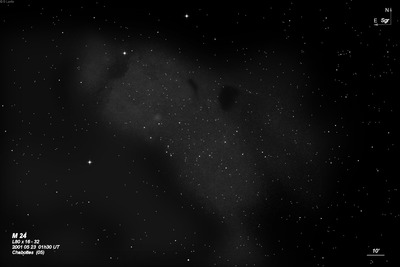Small Sgr Star Cloud
Small Sgr Star Cloud

Charles Messier "discovered" M24 = "Small Sagittarius Star Cloud" = IC 4715 telescopically on 20 Jun 1764, although it is of course a prominent naked-eye object. E.E. Barnard photographed the region in 1905 and described in AN 4239 ("Some notes on nebulae and nebulosities"), "The magnificent star cloud...is remarkable for the definiteness and angularity of its south and following outlines. The east side is about 42' long and is very straight. The south side is somewhat irregular and much longer. The run south preceding for about 90' and then joins the great bed of nebulous matter just described. The northern edge of this star cloud is diffused. In the cloud towards its northern edge, are two remarkable black holes..." His position, though, was 10 min of RA too large, so Dreyer didn't recognize it as M24. Brent Archinal caught the error and made the equivalence (see Corwin's identification notes). William Herschel apparently first observed M24 on 2 Aug 1783 with his 12-inch and noted "considerable stars in great number." John Herschel lists his cluster h2004 = NGC 6603 as M24, so he didn't realize the Messier entry applied to the entire star cloud, not the small embedded cluster.
200/250mm - 8" (7/3/80): IC 4715 refers to the remarkable Small Sagittarius Star Cloud (prominent naked eye object). Best view at very low power as it extends beyond the edges of the field. The rich open cluster NGC 6603 is embedded in the NE side.
Notes by Steve Gottlieb